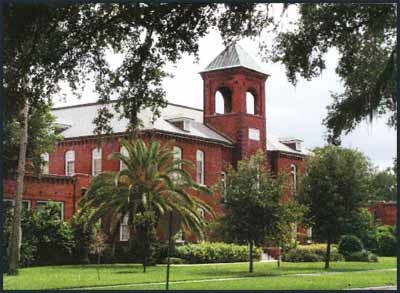The University of Central Florida soon will take a trip into the past – by way of its first Public History Center, where students and the community will be able to work together to preserve the region’s history.
A new partnership between UCF and Seminole County Public Schools is transforming a 110-year-old Sanford school building into a learning laboratory for education, research and community engagement.
The center at 301 W. 7th St. has been preparing this summer to reopen its doors to the public Monday, Aug. 6. The first scheduled activity is 9 a.m. Aug. 13 with Seminole’s traditional ringing of the tower bell to open the first day of the new school year.
This inaugural event and many additional activities will be planned to fulfill public history’s goal of engaging the community.
“We would love to see this become a model for other centers around Central Florida,” said Rosalind Beiler, UCF’s director of Public History. “The building is a gem. The place has a heart and soul, and anyone who spends time here becomes devoted to it.”
Looking back: The building is one of the few surviving Florida examples of school architecture from the turn of the 20th century. It opened in 1902 as Sanford’s first high school and became a grammar school in 1911. In 1984 it was listed on the National Register of Historic Places and became the school district’s Student Museum and Center for the Social Studies, an interpretive center and a hands-on teaching museum.
Looking ahead: The new Public History Center will schedule classes for UCF students, offer community workshops, and promote involvement in historic preservation, while continuing popular programs such as hosting public tours and school field trips. Fourth-grade classes, specifically, schedule visits to the site because of Florida requirements to study state history at that grade level.
UCF signed a two-year lease for the center in the heart of Sanford’s residential historic district, whose residents are encouraged to join in the programs and research.
“The center will enhance the quality of life in our community by bringing to light the history of its most valuable resource: its people,” said José Fernández, dean of the College of Arts & Humanities, which will oversee the center.
Beiler said UCF chose Sanford for the Public History Center because the city has a “rich documented history” and is committed to historic preservation through the Community Redevelopment Association, Historic Preservation Board, Sanford Historic Trust, and other history-related groups, museums and projects.
“There are a lot of willing partners in Seminole County,” she said. “Sanford is among the strongest of any Central Florida city for historical preservation.”
To capitalize on that, Ashley Wilt, program coordinator, is focusing a big part of the first semester’s activities on community outreach, hosting gatherings and enlisting volunteers to assist the center in carrying out projects.
Beginning Aug. 6, the center will open 9 a.m. to 5 p.m. Monday, Tuesday, and Thursday through Saturday. In addition to the Aug. 13 bell-ringing ceremony, the staff is planning an evening open house, neighborhood block party, fall pumpkin festival around Halloween, and an old-fashioned Christmas event. They also are reaching out to scouting and other civic groups to hold activities at the center.
Next spring, the staff and university students will start to offer workshops on historical preservation and topics such as how to interview people for oral histories.
“We are thrilled with this collaborative effort,” said Tina Calderone, chairman of the Seminole County School Board. “This will enhance the educational experiences of our students, allow the center to be open more hours, and benefit the community as a whole.”
The center has several themed rooms: a furnished, original 1902 classroom complete with a portrait of then-President Theodore Roosevelt; a Timucua room that represents a 1,200-year-old village; a pioneer room with a log cabin and tools; Grandma’s Attic with old household items and vintage clothes; Georgetown and Crooms High School exhibits that feature the city’s African-American community, and other displays.
Behind the museum is a demonstration garden that contains vegetables and flowers grown at the turn of the last century, Florida native plants, antique roses, wildflower meadow, field crops and other horticultural displays.
The city’s Touhy Park across the street from the museum contains a historic tree grove, which contains about 70 trees that are associated with people, places and events around the country. There are sycamores, magnolias, maples, walnuts and others from Valley Forge, Gettysburg, Mount Vernon, Ellis Island, the Alamo and elsewhere.
City officials also are pleased that the schoolhouse, which was put on the Florida Trust for Historic Preservation’s list of the state’s most endangered historic sites in 2009, has been given new life.
“This building and project are being looked at statewide as a preservation success,” said Christine Dalton, the city’s historic preservation officer. “They’re utilizing the building, site, its collections and the gardens – resulting in a hands-on learning environment for the students. UCF’s partnership with the museum is a great benefit to the community, and will have a positive impact on this National Register site and surrounding residential neighborhood.”
City Commissioner Patty Mahany, who is scheduled to speak at the opening-day ceremony, said: “This is so significant because it is a great use for the historic building. It is a wonderful marriage and will benefit students with a much higher purpose.”
The building is about 20 miles northwest of UCF’s main campus, which is part of the plan to reach into the community.
“Our name – Public History Center – means just that,” Beiler said. “It is a community resource and we invite Central Florida residents to take an active role and join us as this unique collaboration develops.”
